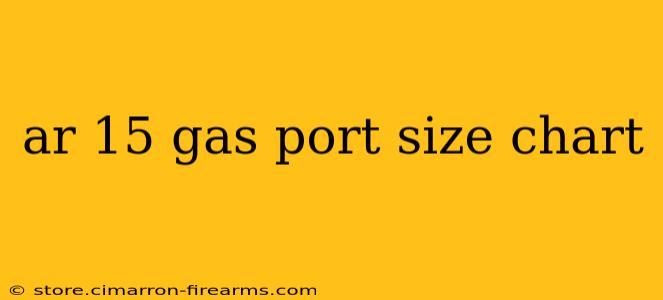Understanding your AR-15's gas port size is crucial for reliable operation and optimal performance. The gas port, a small hole drilled in the barrel, regulates the amount of gas pressure directed into the gas tube, ultimately cycling the bolt and ensuring proper function. An incorrectly sized gas port can lead to malfunctions, ranging from failures to cycle to excessive wear and tear. This guide provides a comprehensive overview of AR-15 gas port sizes, their implications, and factors to consider when choosing or modifying your system.
Understanding Gas Port Size and its Impact
The diameter of the gas port is measured in thousandths of an inch. Common sizes range from 0.0625" to 0.078", but variations exist depending on barrel length, gas system type (carbine, mid-length, rifle), and ammunition used. The size directly impacts the amount of gas entering the system.
- Too Small: Insufficient gas can lead to unreliable cycling, especially with heavier ammunition or suppressed configurations. The bolt may not fully go into battery, resulting in jams or misfires.
- Too Large: Excessive gas pressure can cause rapid wear and tear on components like the bolt carrier group, and lead to excessive recoil. It might also cause the gun to short-stroke, leading to malfunctions.
Gas System Types and Their Influence
The length of the gas system significantly affects the optimal gas port size.
- Carbine Gas System: Shorter barrels and a shorter gas system require a larger gas port to properly cycle the action.
- Mid-Length Gas System: Offers a balance between carbine and rifle systems, often requiring a medium-sized gas port.
- Rifle-Length Gas System: Used with longer barrels, these systems generally require a smaller gas port due to the longer distance the gas has to travel.
AR-15 Gas Port Size Chart (Approximate Values)
Note: These values are approximate, and the optimal gas port size can vary based on several factors including manufacturer specifications, ammunition type, and barrel profile. Always consult your firearm's manufacturer's specifications. This chart is for informational purposes only and should not be taken as definitive guidance for modifying your gas system.
| Barrel Length (inches) | Gas System Type | Approximate Gas Port Size (inches) |
|---|---|---|
| 10.5-11.5 | Carbine | 0.078 - 0.080 |
| 14.5-16 | Carbine | 0.070 - 0.075 |
| 16-18 | Mid-Length | 0.068 - 0.072 |
| 18-20 | Mid-Length/Rifle | 0.065 - 0.070 |
| 20+ | Rifle | 0.0625 - 0.065 |
Factors Affecting Gas Port Size Selection
Besides barrel length and gas system type, other factors influence the ideal gas port size:
- Ammunition: Heavier ammunition requires more gas pressure for reliable cycling.
- Barrel Profile: A thicker barrel profile may retain more heat, affecting gas pressure.
- Suppressor Use: Suppressors significantly reduce gas pressure, often requiring a larger gas port size for reliable operation.
Modifying Gas Port Size: A Word of Caution
Modifying the gas port size is a complex procedure requiring specialized tools and expertise. Improperly drilling or resizing the gas port can permanently damage your firearm. It's highly recommended to have this done by a qualified gunsmith.
Conclusion
The gas port plays a critical role in your AR-15's functionality. While this chart provides a general guideline, understanding the factors influencing its size is essential for optimal performance. Remember that this information is for educational purposes, and professional gunsmith assistance is strongly advised for any modifications. Always prioritize safety and adhere to responsible gun ownership practices.

